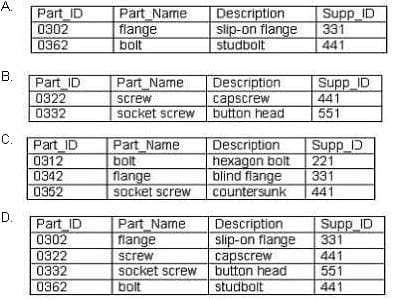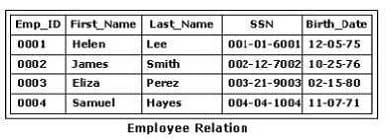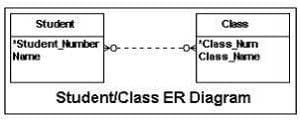1D0-541 Online Practice Questions and Answers
Questions 4
Consider the following relational algebraic expression as well as the Dept1_Parts and Dept2_Parts relations shown in the exhibit:

Which of the following relations would result from the given relational algebraic expression?

A. B. C. D.
Questions 5
Consider the table for an employee database shown in the exhibit. What is the cardinality of the table?

B. 20
C. 4
D. 25
Questions 6
What is the highest normal form of the relation(s) shown in the exhibit?

A. Third normal form
B. Second normal form
C. Boyce-Codd normal form
D. First normal form
Questions 7
Your enterprise must decide whether to use a database management system. Which of the following lists four advantages of using a DBMS?
A. Management of data redundancy, increased data integrity, increased data dependence, and increased application complexity
B. Consistency of data, adherence to standards, managed concurrency, and increased software complexity
C. Increased data access, increased data backup and recovery, data sharing, and consistency of data
D. Increased data security, increased data integrity, increased data independence, and decentralization of data
Questions 8
Which three pieces of information did E. F. Codd describe as necessary to retrieve a data value from a relational database?
A. Attribute, domain, and tuple
B. Entity, relation name, and domain
C. Table name, primary key, and entity
D. Attribute, relation name, and primary key
Questions 9
Consider the entity-relation (ER) diagram shown in the exhibit. When the logical database design phase is completed, which of the following is a valid DBDL description of the base relations for the ER diagram?

A. STUDENT( Student_Number: integer NOT NULL Name: variable length character string length 20 NOT NULL) Primary Key Student_Number CLASS( Class_Num: integer NOT NULL Class_Name: integer NOT NULL) Primary Key Class_Num
B. STUDENT( Student_Number: integer NOT NULL Name: variable length character string length 20 NOT NULL) Primary Key Student_Number
CLASS(
Class_Num: integer NOT NULL
Class_Name: integer NOT NULL)
Primary Key Class_Num
Foreign Key Class_Num References STUDENT
C. STUDENT( Student_Number: integer NOT NULL Name: variable length character string length 20 NOT NULL) Primary Key Student_Number STU_CLASS( Student_Number: integer NOT NULL Class_Num: integer NOT NULL) Primary Key Student_Number CLASS( Class_Num: integer NOT NULL Class_Name: integer NOT NULL) Primary Key Class_Num
D. STUDENT( Student_Number: integer NOT NULL Name: variable length character string length 20 NOT NULL) Primary Key Student_Number STU_CLASS( Student_Number: integer NOT NULL Class_Num: integer NOT NULL) Primary Key Student_Number CLASS( Class_Num: integer NOT NULL Class_Name: integer NOT NULL) Primary Key Class_Num
Questions 10
Consider the following SQL statement and the Orders relation shown in the exhibit:

What is the output of this SQL statement?

A. B. C. D.
Questions 11
Consider the Registration relation shown in the exhibit. Which of the following SQL statements would return all tuples that have course codes beginning with the letter M?

A. SELECT * FROM Registration WHERE Course_Code = M#;
B. SELECT * FROM Registration WHERE Course_Code LIKE M_;
C. SELECT * FROM Registration WHERE Course_Code LIKE M%;
D. SELECT * FROM Registration WHERE Course_Code = M%;
Questions 12
Which process is used to prevent the current database operation from reading or writing a data item while that data item is being accessed by another operation?
A. Lock
B. Deadlock
C. Timestamp
D. Batch
Questions 13
Consider the Information Engineering diagram in the exhibit showing a conceptual data model of the relations BUILDING and RESIDENT. What is the next step in refining the data model?

A. Create intermediate entities.
B. Create a logical data model.
C. Resolve many-to-many relationahips.
D. Identify and resolve complex relationships.
